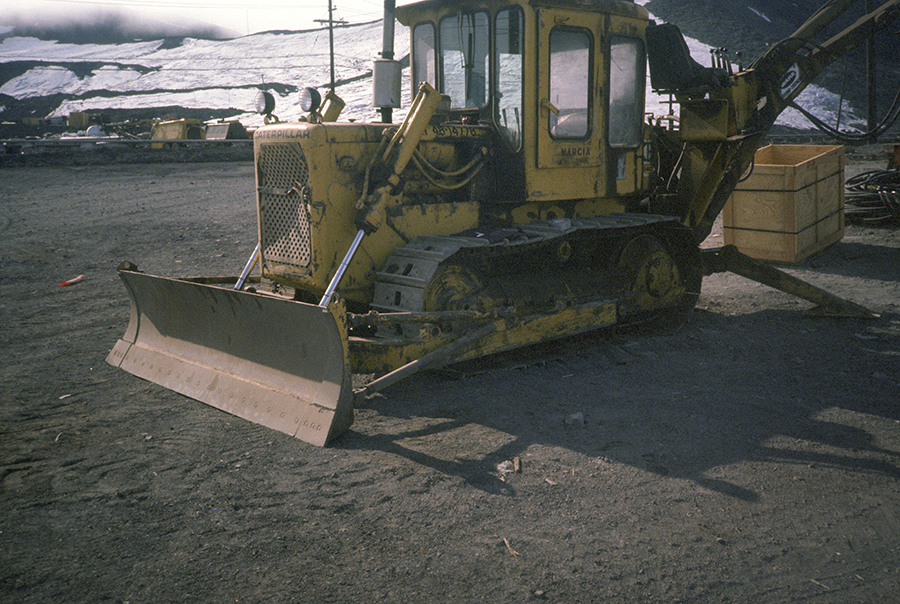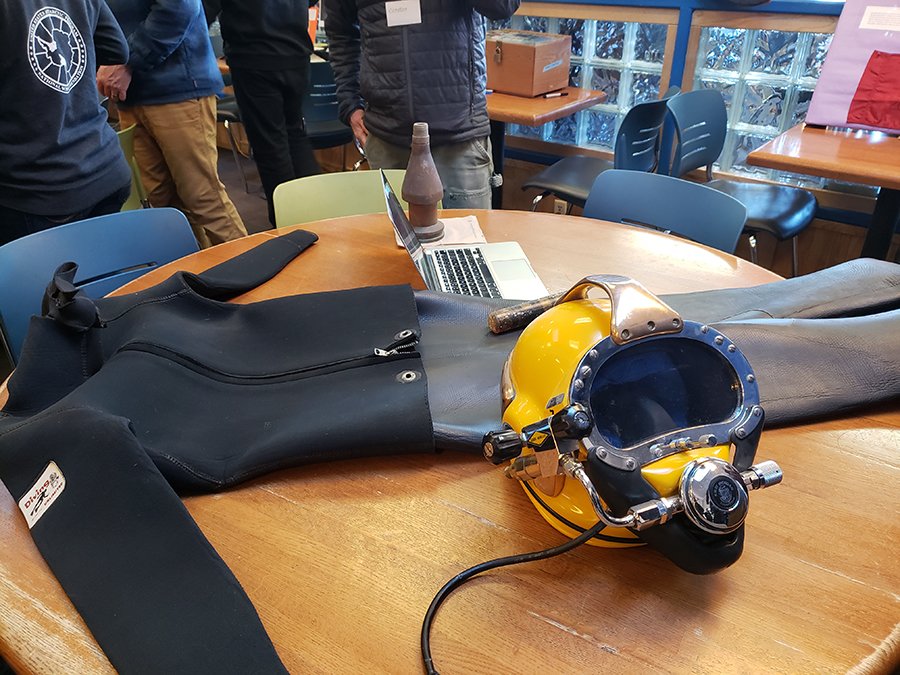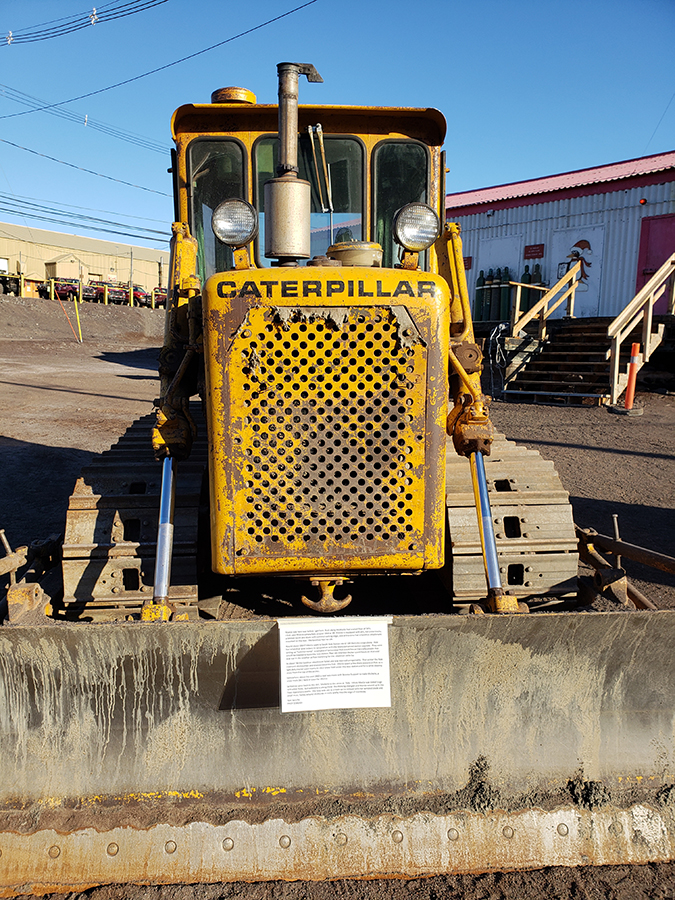
Photo Credit: NSF |
An old Caterpillar D4D tractor nicknamed Marcia at McMurdo Station. This photo was taken in 1971. |
Looking back at McMurdo's history
The 'McMurdo Museum' shows residents what life on station was like in years past
By Lindsey Robinson, Antarctic Sun contributing writer
Posted February 28, 2022
The saying goes that you can only truly appreciate the present when you understand the past, and residents of McMurdo Station recently had the opportunity to view some of the station's past firsthand.

Photo Credit: James Graham
Dave Burris and Adam Peattie look on as Logan Wedum operates the historic MacTown Lane pin setter.
On Wednesday, January 19, McMurdo staff organized the annual one-night-only pop-up museum in the station's galley, displaying artifacts and literature from McMurdo's nearly 70-year history. Diners were asked to finish their meals early or to dine in the back of the galley as a wave of volunteers flooded the main dining room to set up.
Nearly every facet of McMurdo life was represented in the museum, from games and recreation to weather and science. Recreation supervisor Kelly Swanson organized the event with the help of a large group of volunteers from various work areas on station. Representatives from the galley, janitorial staff, Berg Field Center, Field Safety and Training, and even the McMurdo Chapel, Our Lady of the Snows, brought out memorabilia for display. Residents of neighboring Scott Base visited the museum, as well as residents of McMurdo.
A hand-drawn timeline of McMurdo's history, created for the first museum on McMurdo's 60th anniversary, let museum-goers trace the history of the station, starting with its completion in 1956 by the U.S. Navy Construction Battalion known as the Seabees.
The evening was interactive as well as informative. Participants played games of Oregon Trail on a resurrected Macintosh SE (spoiler alert: you still die of dysentery), read all about 'Maxine,' the hovercraft experiment of 1988, and bowled on the restored 'Mactown Lane' that was commissioned in 1961 but torn down during demolition of the building that housed it during the 2009-2010 austral summer season.

Photo Credit: Lindsey Robinson
Jimmy Stewart's wet suit on display at the 2021-2022 season McMurdo Museum.
Diver Rob Robbins stood by a display of a wetsuit used by Jimmy Stewart. Not the actor, he explained, but long-time Dive Safety Officer for the U.S. Antarctic Research Program (later renamed the U.S. Antarctic Program). In the 1960s, the National Science Foundation tasked Stewart with developing safety and operational protocols for diving in the waters around McMurdo station to collect scientific specimens.
Despite years of storage, the suit looked as if Robbins could have slipped into it and gone in search of sea spiders any time he wished. Wetsuits at McMurdo were replaced with drysuits in the 1970s, which are much more practical for diving in the frigid Antarctic waters. Drysuits keep divers warm by creating a pocket of air between the suit and the diver's body.
“I don't have a very accurate idea of the last season that the suit may have been worn, but I can say that in general, drysuits were much in use in McMurdo by 1976 and I can't imaging Jimmy diving in a wetsuit once drysuits were a thing,” Robbins said.
The suit also represents a special person in Robbins's development as a diver.
“Jimmy was an important mentor to me as I switched from commercial diving to science diving in the mid-1990s,” Robbins said. “He was certainly one of the most impactful people in USAP diving.”
Outside the galley, museum-goers viewed an old Caterpillar D4 tractor called Marcia. The tractor's year of origin was not given, but a description written by former staff member Tom Verville said she was used as far back as 1988.

Photo Credit: Lindsey Robinson
Marcia the tractor basks in the late evening sun while on display.
The Antarctic Fire Department had a large setup highlighting former crews, firefighting equipment, and some of the most significant fires of McMurdo's past. Included with the display was a binder of photographs documenting the 2017 renovation of the MacOps (now Central Communications) building and the 2004 visit of local celebrity Sir Edmund Hillary. Lieutenant Bill Harasti and firefighters Chris Robinson and Jon Magyar stood by to answer any questions that came to mind.
The medical department's display included a 1966 Mark 8 Bird respirator, the 2nd model of this life-saving machine released by biomedical engineer and aviator Forrest Bird.
With the help of station management, galley staff, an army of volunteers, and cooperation of late diners, this year's McMurdo Museum came together to provide an event that was not only entertaining but also helped to deepen the appreciation station residents all have for their home 'on the Ice.'
Lindsey Robinson is a firefighter and emergency dispatcher at McMurdo Station who is spending her first season in Antarctica.








